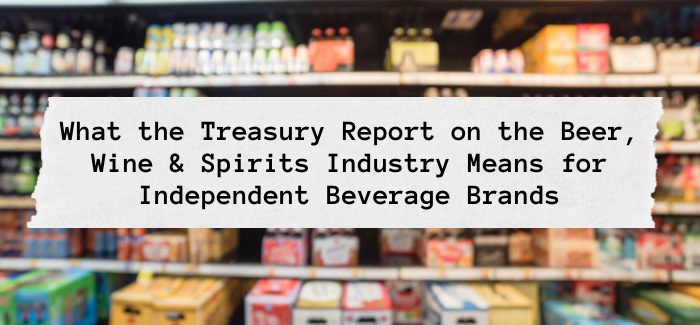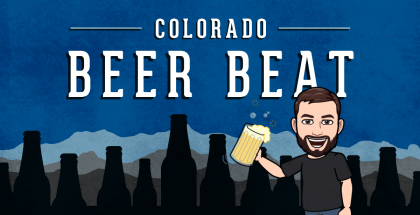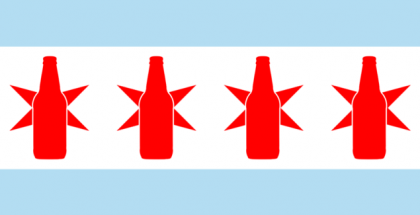Competition in the Beer, Wine & Spirits Industry
Back in July 2021, the Biden Administration issued Executive Order 14,036 focused on “Promoting Competition in the American Economy.” An Executive Order is a broad directive from the Executive Branch that sometimes can act as an immediate law. The goal of Biden’s EO last year was to draw attention to consolidation and competition in various industries in order to provide benefits to consumers in the form of better service, more product choices, and lower prices, as well as provide guidance for regulatory agencies to provide a more level playing field for small businesses. In this instance, Executive Order 14,036 specifically addresses competition in the beer, wine, and spirits industry.
As part of the EO, the Secretary of the Treasury, the TTB (Alcohol and Tobacco Tax and Trade Bureau), and the FTC (Federal Trade Commission) was tasked to submit a report to the federal government that would assess the market structure and levels of competition in the beer, wine, and spirits industry. The end goal was to produce a comprehensive report that would guide federal and state governing bodies in how to give more purchasing power back to consumers in the form of a more competitive marketplace with fewer barriers to entry for smaller brands in the beer, wine, and spirits industry. Their first step was to issue a request for information from the beverage alcohol community.
Comments and remarks were accepted online from August to November 2021 from all segments of the beverage community — trade associations, industry groups, lobbying organizations, business owners, and everyday fans. The results of this report were released on Feb 9, 2022, by the Treasury Department and contains 64 pages of thrilling legalese and regulatory verbiage about where we stand as an industry and recommendations from the government on how we can improve our current situation.
You can read the full report here (Competition in the Beer, Wine and Spirits Industry), it’s a real page-turner. The following summary is my take on how these regulatory suggestions will affect business plans for small to medium-sized beverage suppliers, distribution businesses, and retail owners.
The Players
There are a ton of government agencies directly involved in this report. If the operation of your beverage business is dependent on interactions with any of these groups, you should keep reading. These are key players that are either responsible for taking action based on suggestions in the report or that have the power to change beer, wine, and spirits industry laws at the federal level.
- The Department of the Treasury (DOT)
- TTB (Alcohol Tobacco Tax and Trade Bureau)
- FDA (US Food and Drug Administration)
- FTC (Federal Trade Commission)
- DOJ (US Department of Justice)
Why issue the Executive Order?
The alcoholic beverage industry has changed dramatically since the repeal of Prohibition in 1933 under the 21st Amendment and since the enactment of the FAA (Federal Alcohol Administration) Act of 1935 – two giant pieces of legislation that dictate how the beer, wine, and spirits industry functions. In fact, our industry is so dynamic, that even some of the statistics cited were inaccurate as of the date of the report release, such as the number of functioning US craft breweries being stated at over 6,400, which is far off from the marketplace that we know today with over 9,000 registered craft breweries.
There are two vital points of concern cited in the report that gives rise to caution by the federal government when it comes to beverage alcohol – the meteoric rise of the number of producers across beer, wine, and spirits industry; and consolidation of businesses within the 3 tier system with a specific focus on mergers and acquisitions.
There are also 8 additional specifics cited by the report that are cause for action by either the federal government or state governments, each one addressed in detail throughout the report and then reinforced with recommendations that governing bodies can take for possible resolution.
These citations include:
- Consolidation in our 3 tier system
- Exclusionary practices that give businesses an unfair advantage over others (i.e. paying to play)
- Complex label approval processes
- Confusing beverage category classifications
- Restrictive state-level distribution laws
- Transparency of ingredients on beverage labels
- Tax rates on various categories of alcoholic beverages
- Laws concerning Direct to Consumer alcohol sales
While it would be ideal to dig deep into all 8 categories, most readers would be asleep by then, so focus here will lie with 3 of the 8 provisions that are vital for beer, wine, and spirits industry members to watch — consolidation in the 3 tier system, exclusionary practices, and restrictions at the state level regarding distribution.
The Duopoly of Brands Controlling the Marketplace
Recommendations by the Department of the Treasury to the Department of Justice and Federal Trade Commission repeatedly call for more oversight when it comes to mergers and acquisitions, especially in the supplier tier. As things stand today, there are two beer brands that control 65% of the marketplace, which is giving them the power to set price levels in retail (which affect consumer purchase decisions), dictate brand mindshare at the distribution level (which means less attention for independent brands), and inhibits independent brands from entering the marketplace, also known as Tacit Collusion, which means that companies are acting in a way that shares monopolistic power without a formal agreement in place in order to keep market entrants out of the game. You can read more about specific tacit collusion instances in the beer, wine, and spirits industry here (US Antitrust Division). Not only is the DOJ going to scrutinize future M&As of suppliers, but they are also reviewing past agreements that might yield these negative results in the marketplace.
What this means for suppliers — more intense scrutiny of M&As means “big beer” might not be able to strong-arm independent suppliers in the marketplace and within distribution houses as much as they have to date. The Treasury Department is letting small to medium-sized producers know that they recognize the struggle for brand mind share within your distribution houses and in the retail marketplace, the lack of ability to compete on pricing at the retail level, and how supplier consolidation leads to an uneven playing field. It’s a step in the right direction for independent beverage brands overall. Make a note to keep an eye on press releases from the Department of the Treasury, the Federal Trade Commission, and the Department of Justice when a big beverage M&A deal hits the media, we might see some regulatory stoppage in the future that wasn’t part of the game over the past decade.
Exclusionary Practices Need to Be Prevented
The layman’s term for most exclusionary practices is basically “pay to play.” Beer, wine, and spirits industry veterans know this happens daily despite extensive regulatory policies from the TTB, but now the federal government is really starting to take notice. Exclusionary practices are defined and enforced according to the FAA Act of 1935, which addresses issues such as exclusive outlets, Tied House, commercial bribery, and consignment sale provisions. More specifically, the report cites Section 105 of the FAA Act that addresses 6 categories of “unfair competition and unlawful practices” in all 3 tiers of the industry. The premise for this section was created over 85 years ago to avoid the creation of an alcoholic beverage black market and to help maintain a healthy level of competition in our industry overall. There is a ton of regulatory verbiage in the FAA Act that can be hard to interpret, so here’s an informal summary of what Section 105 prohibits:
- Suppliers cannot demand that retailers only have access to a certain item if they purchase another certain item
- Suppliers cannot incentivize (induce) wholesalers or retailers to sell their brands, and wholesalers cannot incentivize (induce) retailers to sell their brands in any way
- This includes gifts, cash payouts, bribes, rewards, rebuying unsold products, and special payment arrangements like consignment sales or slotting fees (payment for a retail placement)
- Suppliers and wholesalers should not be dictating shelf schematics for retailers, also known as Category Management
- Suppliers are not allowed to exclusively promote and/or advertise product placements for specific retailers under Tied House provisions
What this means for suppliers — the Treasury Department makes multiple recommendations for the TTB in order to better enforce Section 105 of the TAA Act, including becoming more proactive in pursuing cases for violations of exclusionary practices, intensifying punishments for violators of these provisions, and carrying repercussions for violations over to the retail tier. As of this moment, the TTB has been pretty lax about formally addressing exclusionary practice violations with most incidents getting swept under the rug or issuing punitive fees to brands and distributors that consider it worth the cost of doing business. And currently, punishments for violations of the FAA Act are reserved only for suppliers and distributors, leaving retailers free of responsibility. The TTB will be working on a way to hold retailers accountable for “pay to play” violations in the future.
Horizontal Consolidation in the Distribution Tier
The distribution tier of the beverage alcohol industry in the US is a fickle beast at best. While this Treasury Report calls out many of the issues that suppliers have with distribution tier regulations, most of the action that can be taken to revise and improve the situation can only be accomplished at the state level. On one hand, awareness and recognition of independent supplier woes are a step in the right direction, but on the other, it will ultimately be up to industry activists and lobbying groups pushing to change distribution laws with state governments to push for amendments that would level the playing field for independent beverage brands. Some of the issues with the distribution tier that are addressed in this report include:
- State franchise laws that demand suppliers use a distributor to get their brand to market
- Consolidation of distribution businesses across the US that limits choices of wholesalers for suppliers and allows wholesalers to pick and choose the suppliers they want to partner with, instead of competing for supplier brands based on merit and resources
- “Big Beer” dominant wholesalers acquiring smaller craft-focused distributors to shift mindshare away from independent beverage brands
- Post and Hold pricing practices in the distribution tier that dictates consumer alcohol pricing and inhibits competition in the industry
If you are an independent beverage brand in the beer, wine, and spirits industry and have ever been forced to solicit representation from or work with the likes of Reyes Beer Division, Johnson Brothers, Republic National Distributing Company, Breakthru Beverage, and/or Young’s Market Company (all cited in the TD report specifically), then you know how distributor consolidation can negatively impact the attention that your brand receives from your wholesaler, your price to consumer levels in the marketplace, and barriers to entry in the marketplace overall. Case in point, the total number of beer distributors in the US has fallen from 4,595 in 1980 to around 3,000 in 2020 (NBWA Industry Fast Facts). Don’t sleep on the fact that the federal government has literally called out the distribution tier in this report for hindering independent brands from entering the marketplace and having a fair shake in growing their brands. To get your hands on all the juicy details in the report about distributor consolidation, please refer to Section 3.1 through 3.4 of the Treasury Department report (Competition in the Market for Beer, Wine, and Spirits).
What this means for suppliers — you need to get inspired and take action at the state level. The FTC, the Treasury Department, the TTB, and the DOJ can only do so much at the federal level. It’s going to take the voice of the beer, wine, and spirits industry at the state level to enact real change that can encourage a more competitive market landscape by altering distribution franchise laws, Post and Hold pricing practices and horizontal consolidation of wholesalers. The best way for suppliers and retailers to take action is to get to know your senators and make your demands heard or join a local lobbying/advocacy group like your state brewer’s guild or political action committee and restaurant/hospitality associations or a national organization like Spirits United, the American Cider Association, the National Alcoholic Beverage Control Association, or the American Craft Spirits Association.
While some are hailing this report as an anti-big business effort, many are heralding this document as a cry for help for independent beverage alcohol brands nationwide. For those that have been part of the industry for quite some time, this report seems like the light at the end of the tunnel for many who feel that our country’s beverage alcohol laws are antiquated and desperately need a major overhaul to reflect our current market conditions, especially after the effects of the COVID-19 crisis. The ultimate takeaway here is that the beer, wine, and spirits industry is not an afterthought in the eyes of the federal government, which means someone on the Hill is paying attention to our calls for action. This report could be the catalyst for national and statewide reform that would help level the playing field for independent beverage brands and provide consumers with more product choices and attainable pricing. Across the board, that’s a win-win.








Submit a Comment